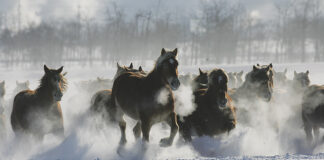Bred for farm work and heavy carriage deliveries, Belgium’s native Belgian draft horse is more commonly seen in show and recreational pursuits today: weight-pulling competitions, in-hand performance or carriage driving. However, some agriculturalists are returning to horses like the Belgian as a more ecologically friendly method of cultivation.

The Belgian is a descendant of a medieval war mount, the Flemish horse, also known as the Great Horse. Later, stallions were exported to countries throughout Europe to add height and substance to other draft-type breeds for industrial and farm work.
American Story
In 1903, the Belgian’s powerful look and skills garnered much positive attention at the St. Louis World’s Fair and International Livestock Exposition in Chicago. Despite declines in numbers during World War II and the switch to mechanized farm equipment, the Belgian survived to become one of most popular draft breeds. Besides their strength, Belgians are loved for being docile, hard-working and hardy.

Belgian Draft Horse Fast Facts
Height: 16 to 18 hands high
Weight: Belgians can weigh more than 1 ton (2,000 pounds).
Color: Acceptable colors include blonde, sorrel and roan with light points, and chestnut. White manes and tails, as well as a white stripe on the face, are preferred.
Overall Appearance: Belgians have well-defined musculature, a level back, large hooves and a deep girth.
To learn more about the Belgian, visit the Belgian Draft Horse Corporation of America website.
Further Reading:
The 10 Biggest Horses: Giants of the Equine World
This article about the Belgian draft horse originally appeared in the December 2017 issue of Horse Illustrated magazine. Click here to subscribe!






